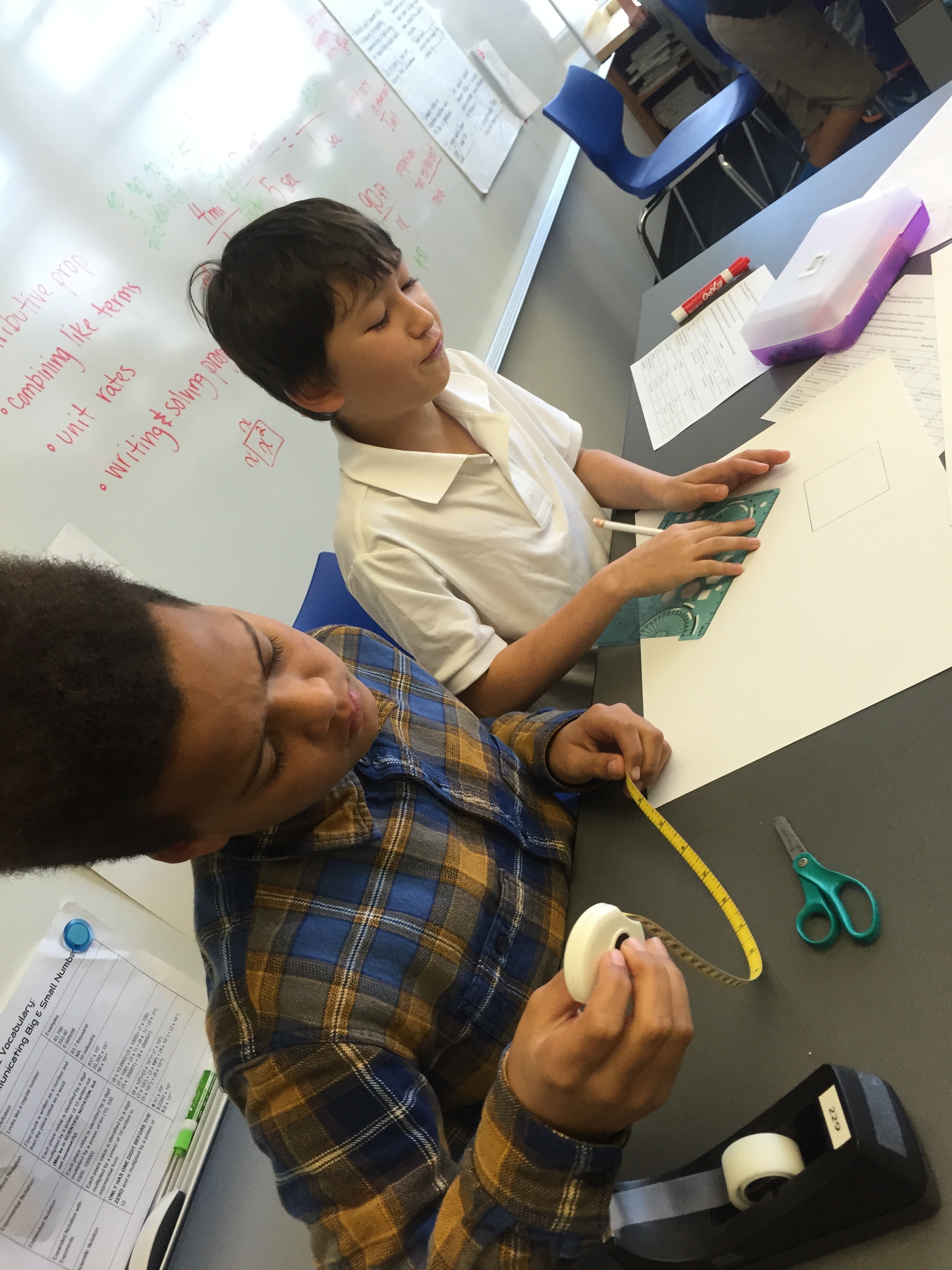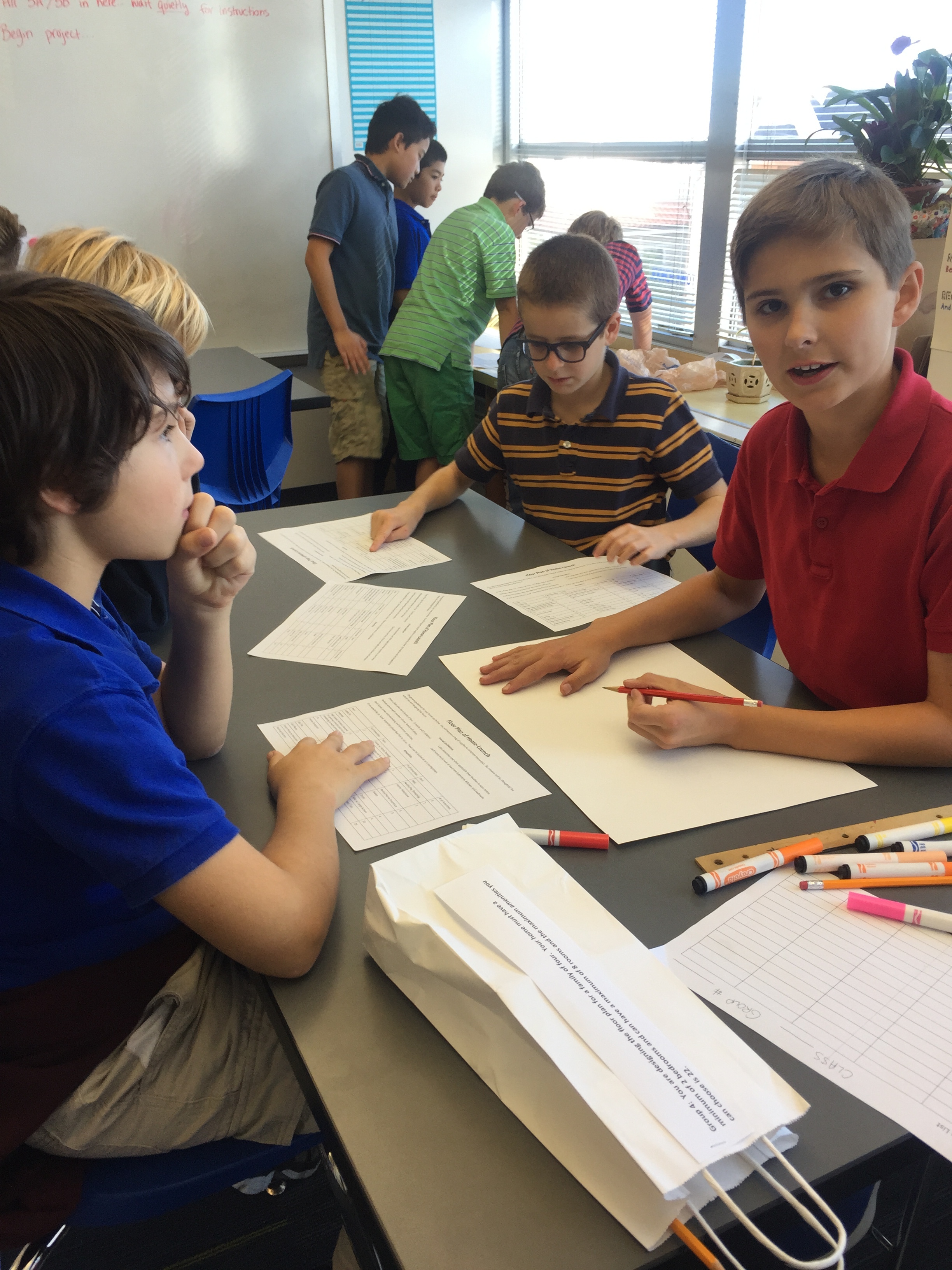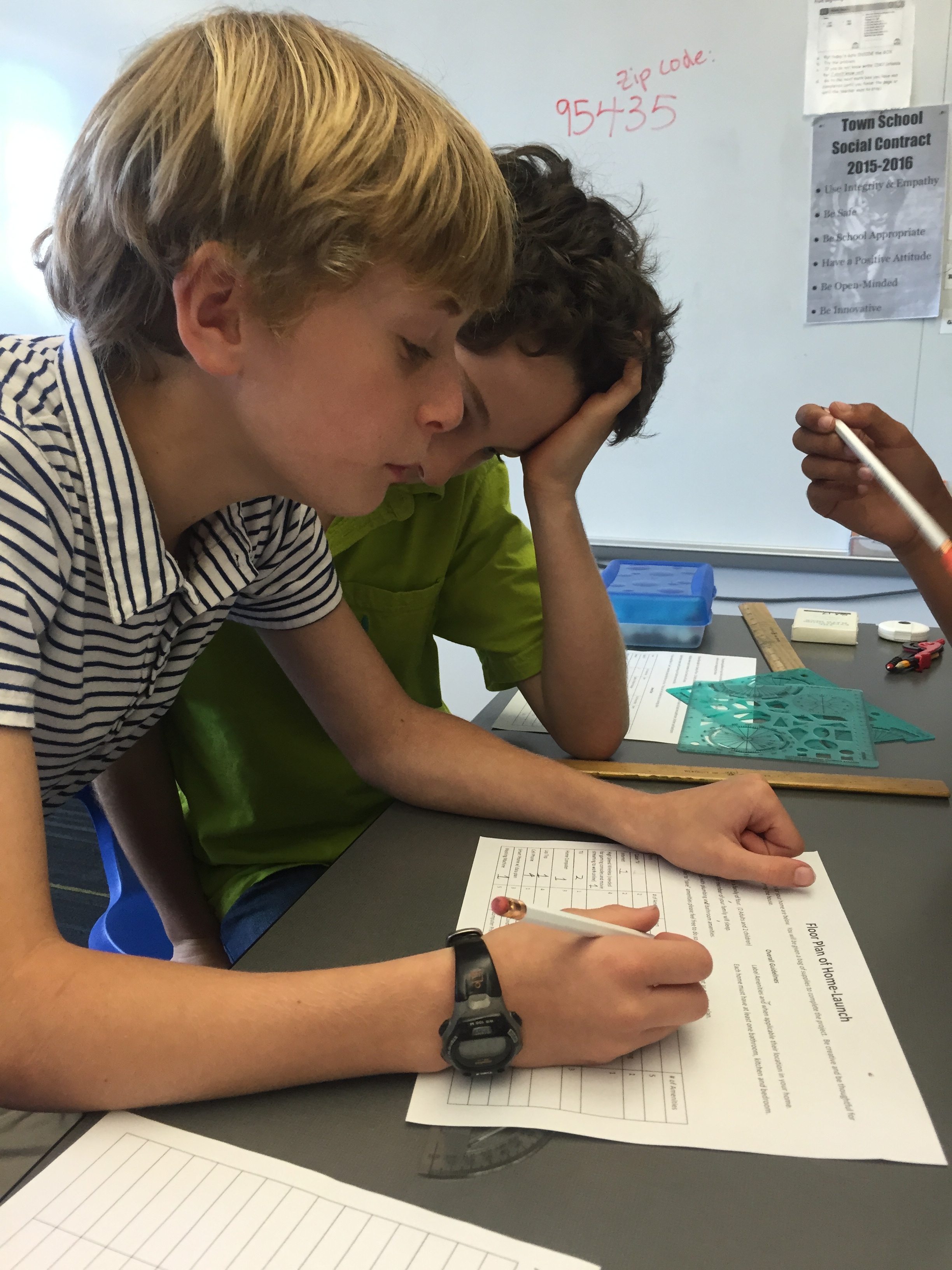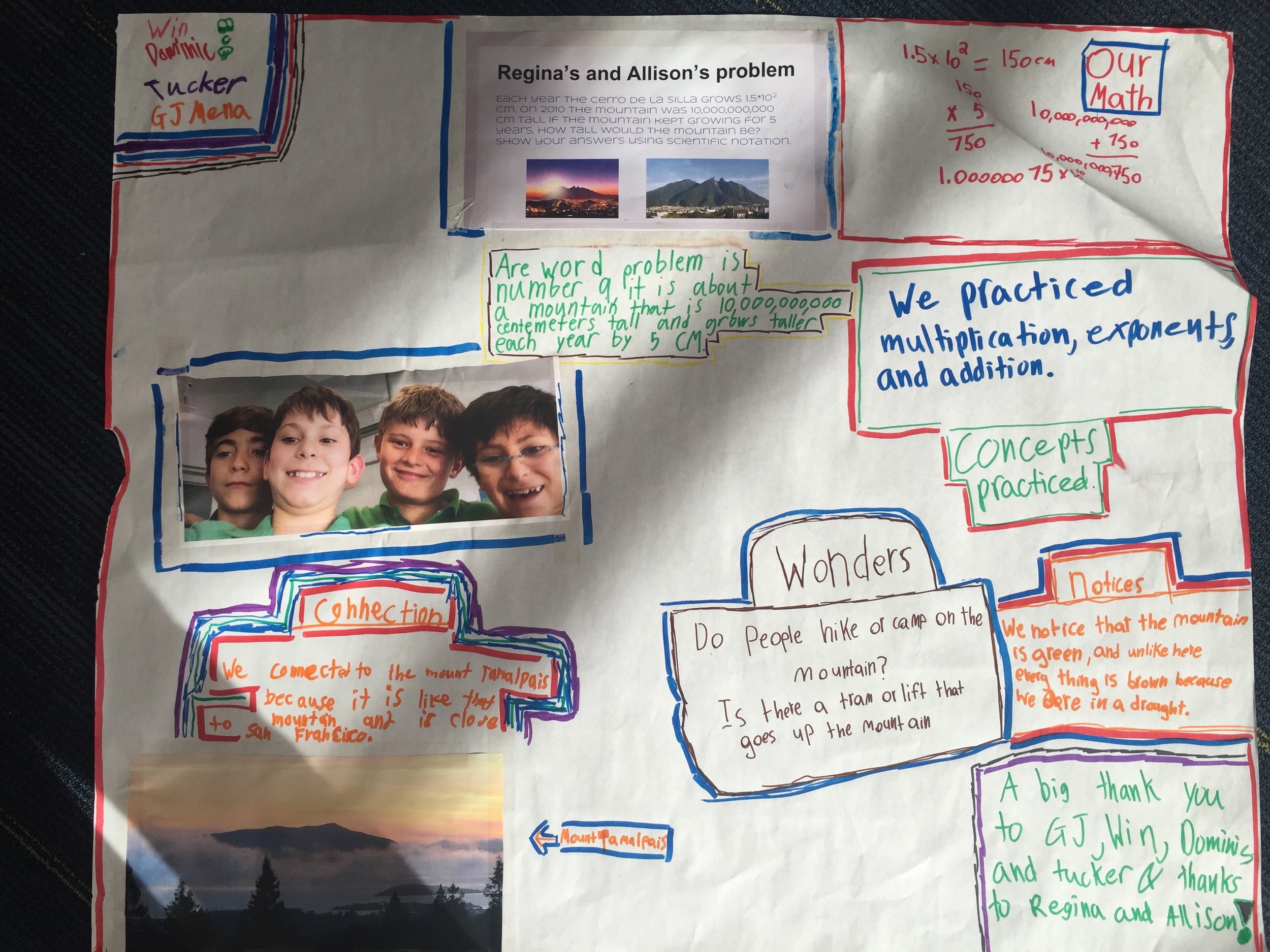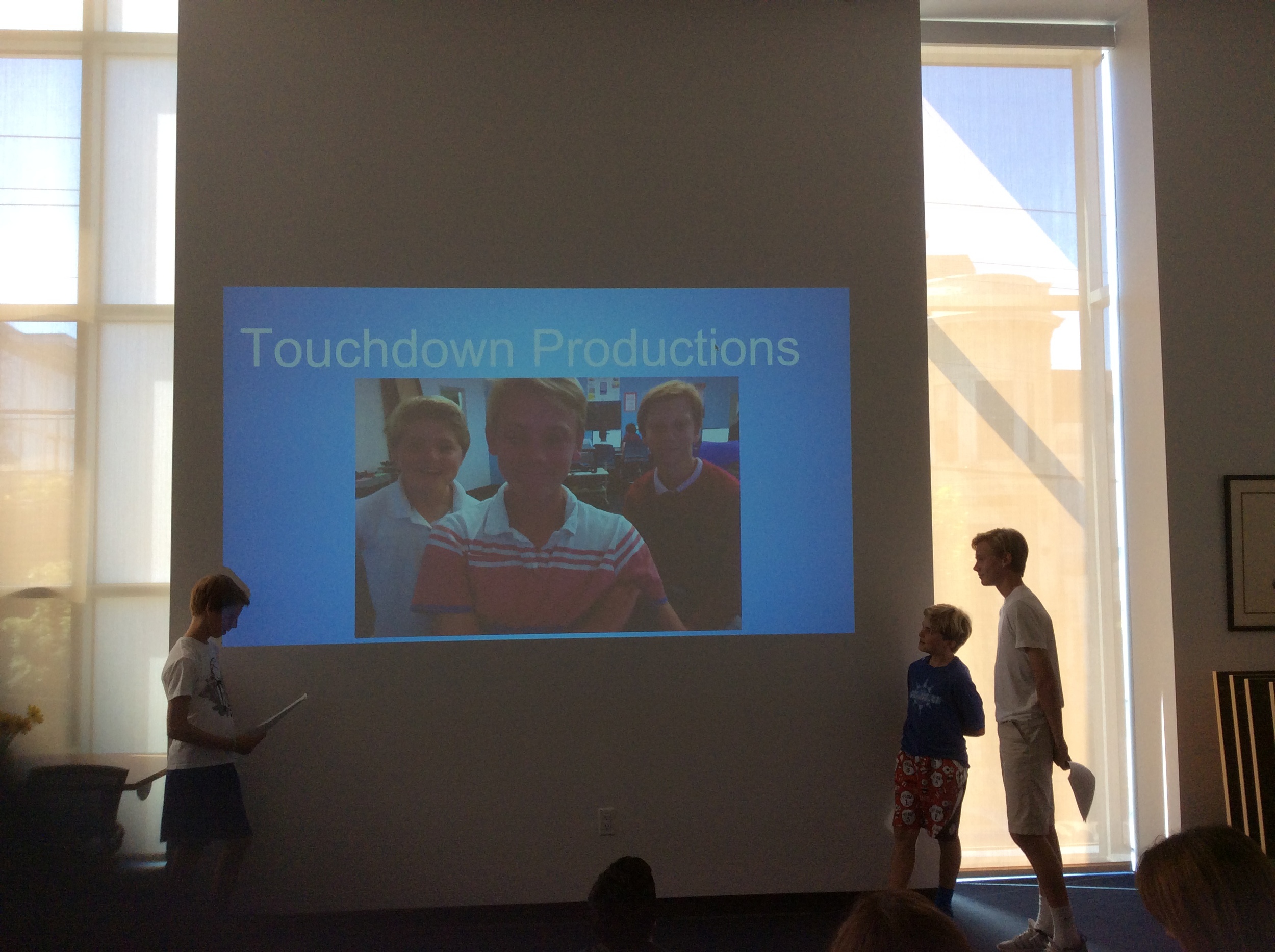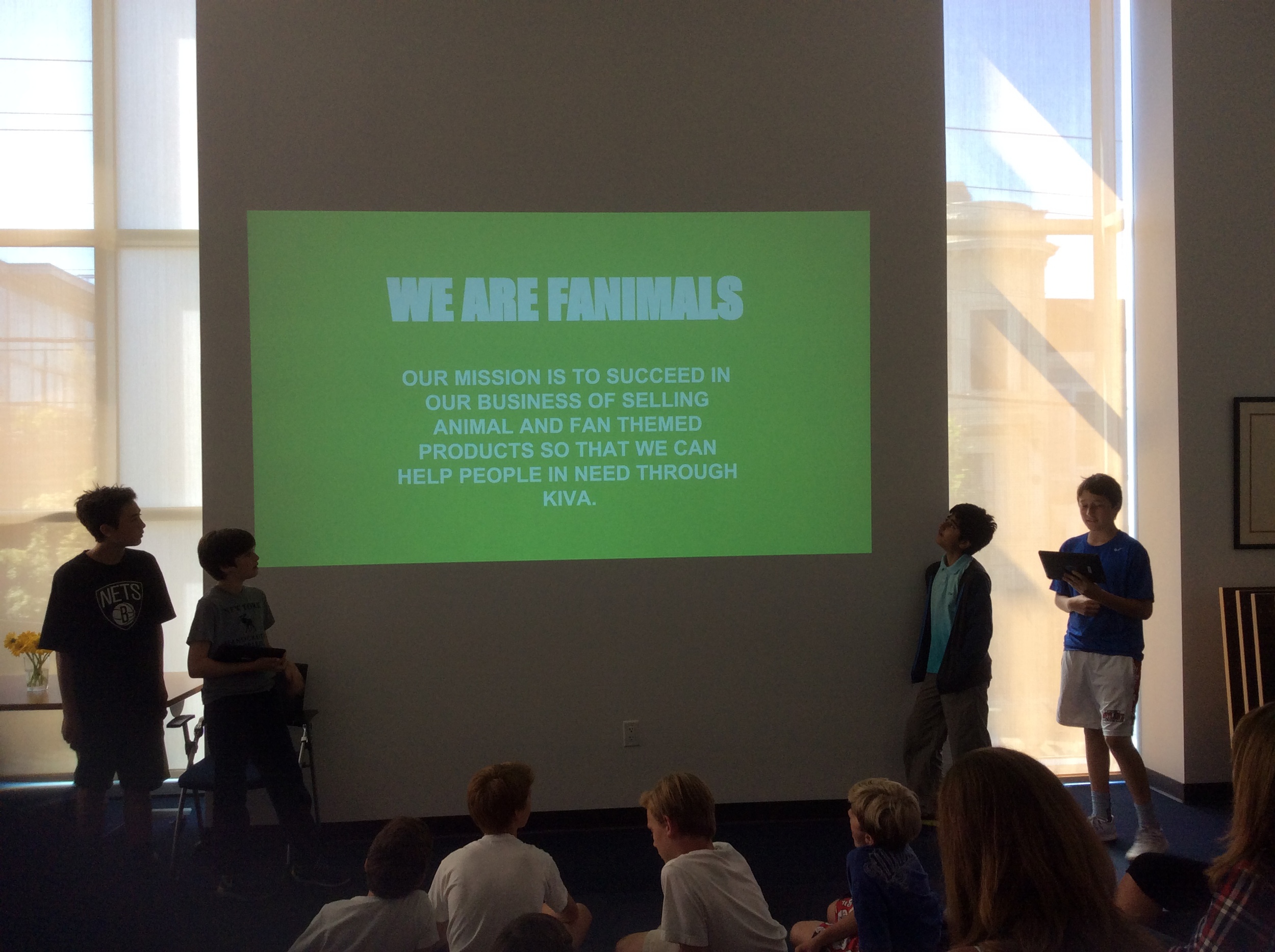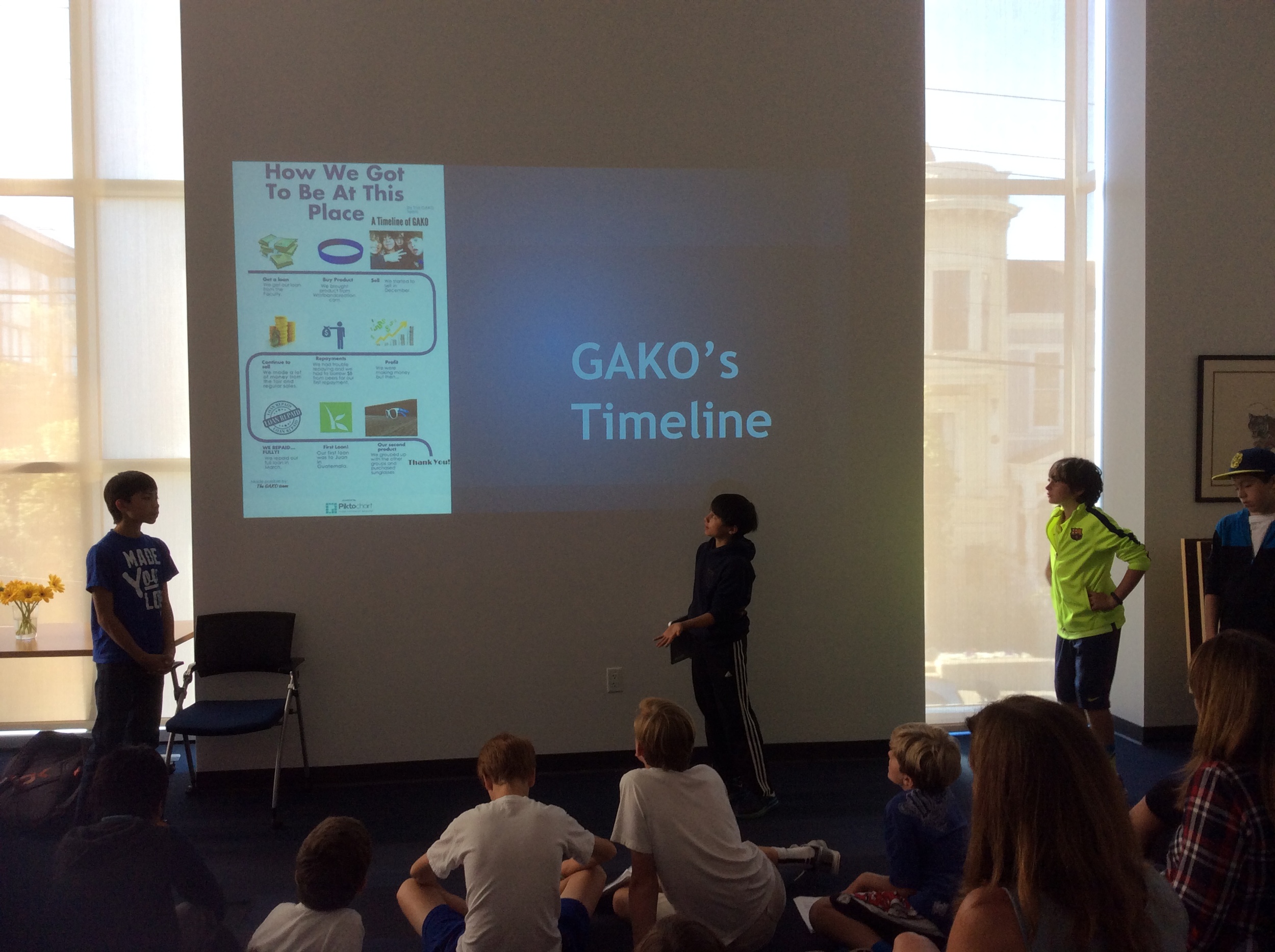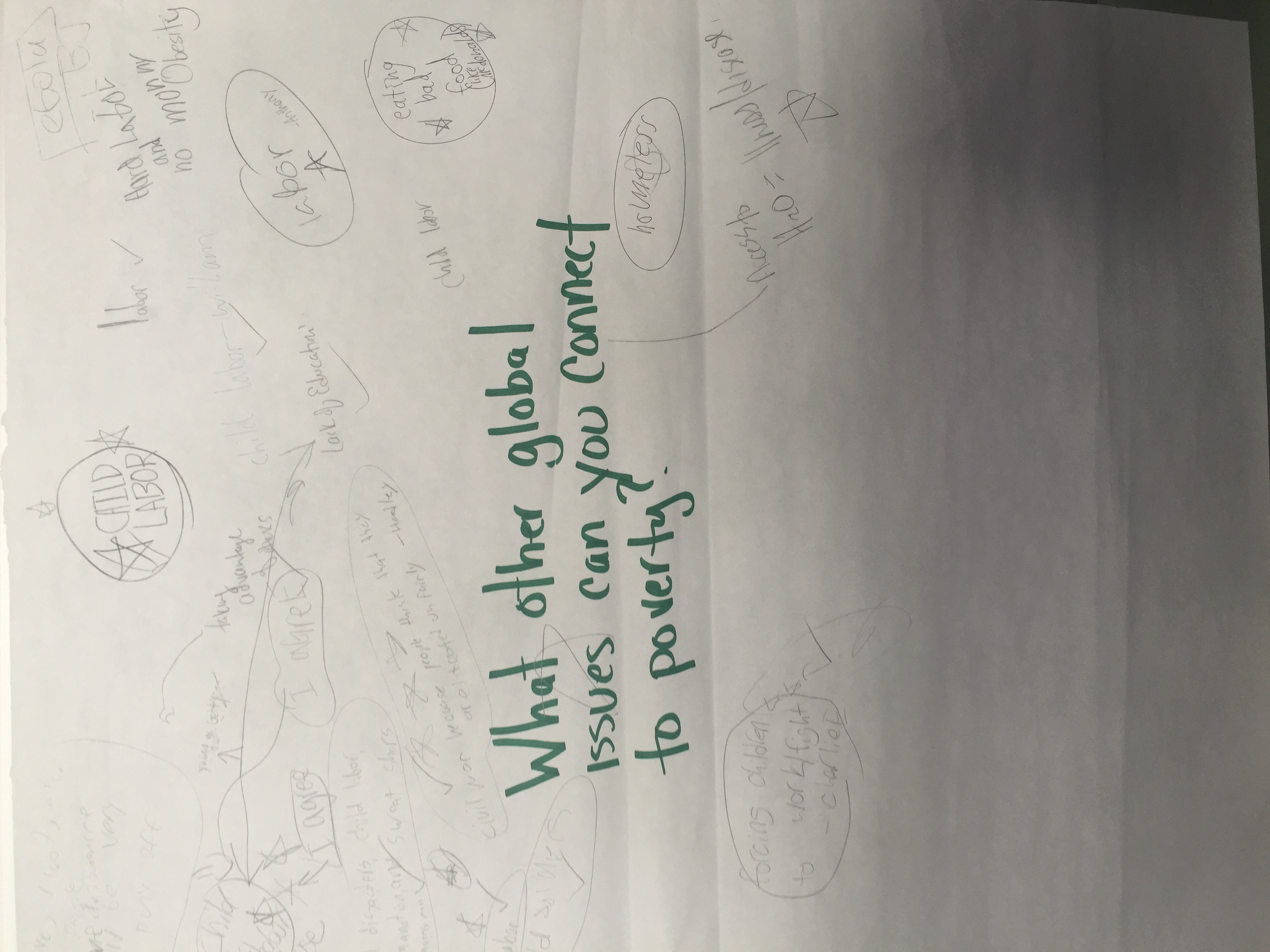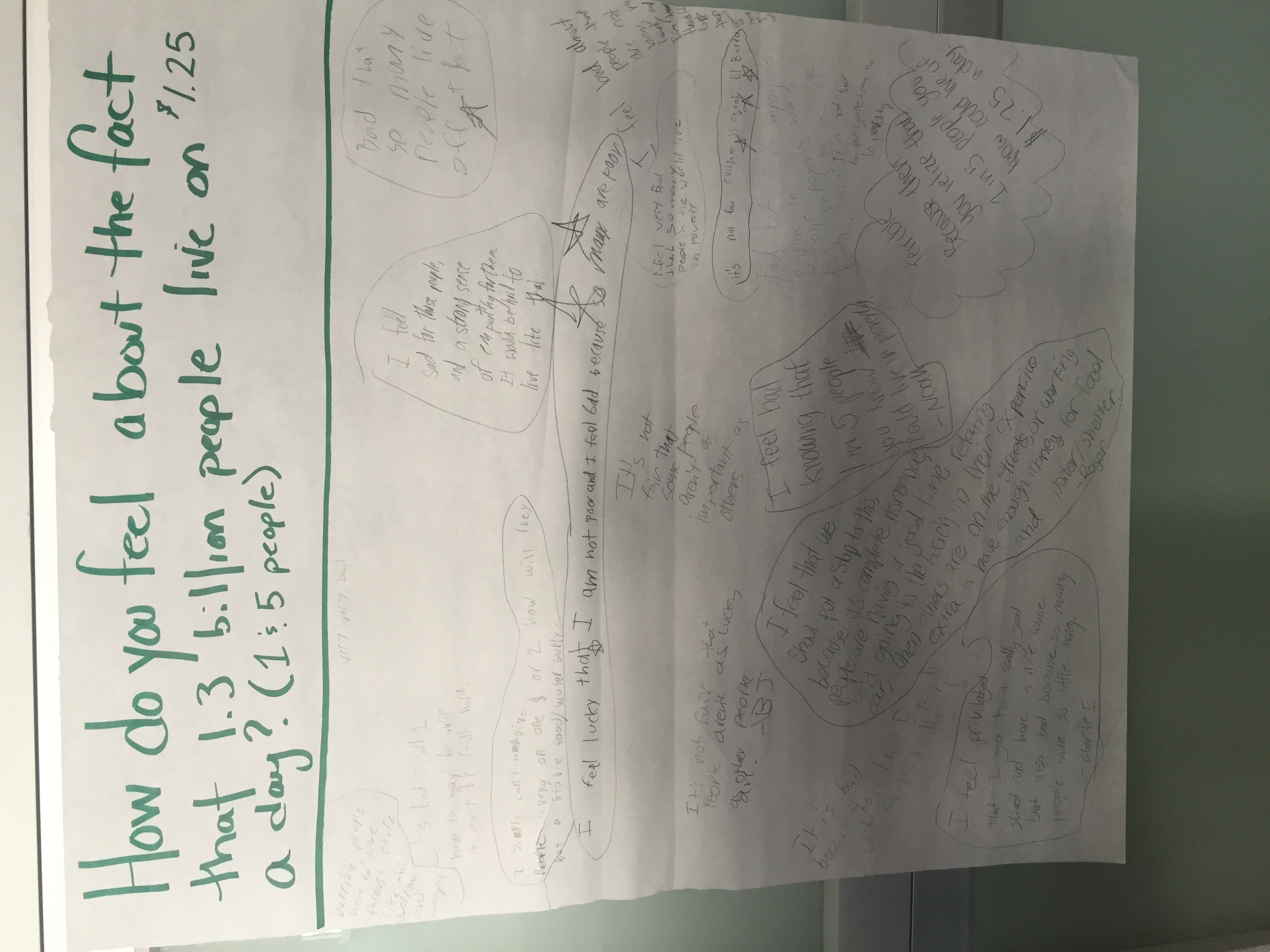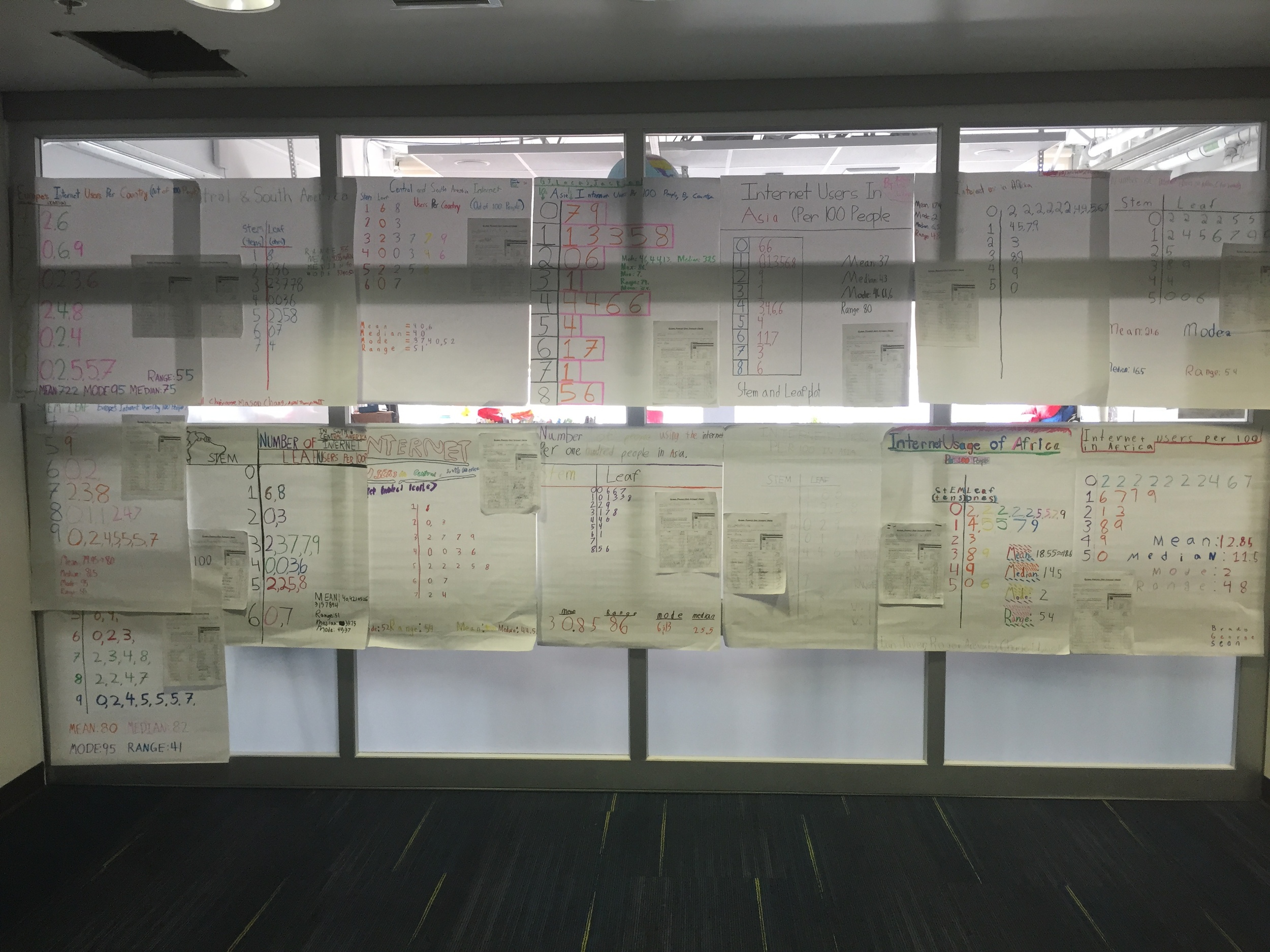Celebration of Learning Kiva Kids 2016
Each year I continue to be amazed by what the boys accomplish at Town School for Boys in conjunction with Kiva.org. This year, in addition to raising approximately $1665 in new funds (equating to 64 loans and a $65 donation), we also had the opportunity to team up with 2nd and 3rd graders to teach them a little about lending and microfinance too! Additionally, the 6th grade Core math class participated in a unit of their own making approximately $400.
The Annual Celebration of Learning is always a wonderful opportunity to have the students share with parents and other community members what they have learned. We also had a special treat- Bumzy's Cookies! (Kiva Zip Borrowers from SF) Feel free to check out our overview video and dive into some of the business presentations too. More lending to come in 2016-2017.
RFL
(Sean, Mason & John)
Squeeze Inc
(Colin, Noah, Lucas & Kitt)
Squishy Squad
(Josh, Jack, Alesso & Ben)
Hacky Town
(Alfred, Harrison, Spencer & Charlie)
Putty Putty
(William, Gordon, & Alex)
Slap Bands +
(Benjamin, Charlie, & Jackson)
It's Not Always BIG- Scientific Notation and Population
While many of the lessons I blog about are part of a larger unit/Pbl, the fact of the matter is going global in my math class is more then just that. I try hard to connect my students with others on a regular basis. While the study of scientific notation has natural connections to their science class, I launched my class the other day with a discussion about the world population. Using this website, the students were able to look at population, population growth and consider population density.
The boys started by choosing 5 countries that resonated with them. While I only had time to have them share 1 of their countries in class, they were excited to have choice and they selected places based on population, places they have visited, places they dream of visiting and heritage. It was interesting to listen to how they connected. From there, as you can see in the worksheet, they had to find the population, round it, and place it in scientific notation. One of their wonders, "will China's population growth change now that they have no restrictions on number of children?" (Great opportunity to talk about statistics, and good data sets based on information over time)
The boys seemed to be able to understand the importance of using the same base number (range 1 to less than 10) when we listed the order and it was no longer a challenge to order them. Additionally they were able to better connect that the exponent was connected to the place value. What an "Aha" moment we had!
After the discussion the boys moved through the real life statistics on the backside of the worksheet. The boys had big feelings as they continued to practice scientific notation, and remarked that the stats made them sad. They connected this to their recent water walk with 1st grade and the poverty project we did earlier this year. In the end, this 1 1/2 hour lesson allowed them to gain greater appreciation for their surroundings, and consider ways they can advocate and help others. Their words, not mine!
"The real world data in this lesson really helped me master it!" -Malyk
So the lessons aren't always BIG and numbers for scientific notation aren't always BIG... but I hope the impact is.
Learning Through Teaching - And Connecting Our Community
In the past, Town School has had a wonderful club called Kiva Council that helps our community re-lend the money we have earned over the years. However, a new schedule and less access to 7th and 8th graders made this nearly impossible this year. I struggled with how to deal with this issue for many months, feeling bad about the $1200 sitting in our account, and even worse the following month as more money was deposited. With so many worthy borrowers on Kiva, we needed to come up with a plan.
The 2nd graders were eager to buy our product and eager to learn about Kiva. Part of their curriculum in 2nd grade is Change Makers and this seemed like a natural connection. So I visited the 2nd graders this Monday and taught them a little about Kiva and our school's connection to the non - profit. Concepts covered briefly were:
Borrowing
Needs vs Wants
Access to Money
Change Makers
6th Grade Businesses and their purpose
But the real fun wasn't in the meeting I had with these boys, but rather in the subsequent activity planned with the 6th graders and 2nd graders. The 6th graders visited the 2nd grade classroom, created small groups and shared their knowledge with the 2nd graders. Then, they made loans. Watching them work together, connect with borrowers and make hard decisions, was amazing. Here is the form we used:)
Here is how some 6th graders described the experience:
The second graders were really excited to make a loan, one of them even wanted to make a loan when he goes home. They were so excited they were trying to make more loans with me. I had a tough time splitting the time for the IPad with the second graders.
I really liked working with the 2nd graders because they were eager and wanted to make a loan. I think it was a great lesson to the 2nd graders to connect with people not only outside our school but all around the world. It was a great experience and I can't wait to do this with the 3rd graders.
I think it was a good experience working with the 2nd graders because it was something new I don't think I have done before. I also thought it was important that the 2nd graders learned about Kiva for later years when they get a little more involved. They also learned more about how they are helping the world with every product they buy and the process the money goes through. At first, my buddies were a little wild and hard to control, but after we started choosing borrowers they became easier to control because they were interested. It was very fun working with the 2nd graders and I think both grades learned a lot.
It was fun to see how the second graders chose loans and connected with the borrower. It was also fun to hear that when they went home they would ask their parents to set up an account for them. It was a lot easier than expected.
As you can see the boys learned a lot and are excited to do the same activity with 3rd graders in late April. In addition, they saw an increase in sales on Friday from 2nd graders, as boys knowledge of "why" to buy increased. Well done!
Celebrating International Women's Day One Loan at a Time
While running businesses in math class provides a lot of valuable math and life lessons, it is important for me to continue connecting their adventures with micro-financing with the many concepts covered in their 6th grade curriculum. And sometimes these lessons appear out of nowhere...
On Friday, the boys revisited the loans they made in connection with Thanksgiving. We took some time to look at how much we had been repaid and what percent of their original loan that equated to. This forced them to subtract (Kiva tells them how much is still invested), and compute a percent. Each of the boys computed their own statistic, essentially checking the work of Kiva, and brought it to our community meeting. Out of 21 boys only one students loan is late in paying back. Immediately the boys calculated if this was in line with Kiva.org's statistics. Pretty close 95% vs 98.4%. We are hopeful:)
The boys companies are doing well, and we discussed when they would likely dive into lending. One group is 100% paid back and doesn't have a goal of creating larger capital so they are ready. While another group hopes to buy customized slap bands and needs more capital. In sharing these observations and realizations we talked a bit about savings and then investments. I told the boys I would be giving them each a loan in honor of Women's Day and we compared and contrasted our decision making process with the money I give them, which is part of a large portfolio (over $4000) vs their companies which are starting with earnings and a much smaller portfolio. The boys discussed field partner risk, repayment periods and personal connections to borrowers.
Monday and Tuesday afternoon's class began with revisiting our loans. The boys had questions about currency loss and I let them know we would do more with currency as we approached our unit on proportions, but explained a little of this to them. Then we revisited our Thanksgiving loans and computed the mean, median, and mode of our Field Partner Ratings. All great review!
Discussing our first loans was a great lead in to the International Women's Day lesson I had planned. After looking at Kiva's slideshow about the event, the boys spoke about the kinds of loans they wanted to make and got right into lending. I asked them to think about why they were making their loans, both objectively and subjectively and made them request their loans to me using the prompts, I notice... I wonder... and I connect to... here is what we came up with...
Benjamin writes: I notice that my person, María, is a cattle farmer in El Salvador supporting her 13 year old son's education for a bright future for him. I wonder how long it will take to pay back and what she uses her cattle for and how exactly she makes money off of it (milk or beef?). I connect because she is working for her son and to make money for her family. She is making sure her son and herself have a brighter future, and I want everyone's future to be bright.
Noah writes: I loaned to Ruth, in Kenya. I notice that she is asking for a loan for her children's tuition. I wonder if she will spend the extra money on her business. I connect, because I have an education, so I want her children to have one too.
I notice that Grace is a mother of three kids. I respect mothers and the commitment they make for their children. I wonder if she has a husband because it does not say that in her profile. I can connect to her because I live in a family with three kids and I respect the sacrifices that my mom makes to make my and my siblings life great.
I notice that the person I loaned to is married and a mother of three which means she needs money to pay for her family but she has an education and has worked hard so now she has a stable job raising cattle. I wonder if at the start it was hard for her because she was a women. I connect that she is a women doing agriculture and in the slide we saw it said that many women do agriculture.
Just Getting Started: Making a Difference on Fair Day
This year's Town School for Boys Kiva Kids are up to old tricks, selling product in the name of micro-lending. As the money poured in from faculty, staff and parents*, the boys got excited to purchase their product and start making money. Fair day at Town occurs every year the day before February holiday week and it seemed the perfect day to launch this years products. 4 out of the 6 groups successfully received product in time to make this happen. The two groups that didn't get their product in time have learned lessons about shipping costs (ouch!), inventory issues (out of stock), and that being on top of things and working as a group is very important. I have faith that watching their peers success on Friday will only in the end make their company stronger in the future.
*In the past I struggled with the idea of having parents become lenders, however after careful consideration I allowed each parent to give up to 10% to their son's company loan in an effort to bridge communication about the project experience and learning.
In addition to selling product, the boys have recently learned how to set up spreadsheets, and create functions (They need to this to set up a BOG -Bank of Goggin). They have also used proportions to discover what their loan size in Kiva Kids would look like on Kiva.org, they have analyzed the Town School for Boys Kiva portfolio to look for trends and gaps, and have had serious discussions about pricing, profit, and building capital. We are just getting started.
Here's to the 2016 Kiva Kid Borrowers
The boys have been busy putting together business plans, filling out borrower applications, and discovering a lot about what it takes to put it all together to become proud business owners. With the help of parents and faculty members, some of our teams are well on their way to being funded in the hopes of opening up shop in the early days of February.
Check out our Kiva Kids Page
I asked the boys to reflect on how it feels to be a borrower and here are some responses:
- As a borrower, I feel pretty good because our group has been loaned to multiple times. I also feel a bit satisfied, knowing that our group is closer to being fully funded. Being a borrower is exciting because you don't know if you are going to be fully funded, and if you aren't, then you can't start your business. I really hope people will loan to us so we can get started on selling our mesh squishy balls to the students.
- I feel that as a borrower it is really exciting checking your loaners and how much you have because every time you are that much closer to getting your loan. The one thing that I feel is hard about being a borrower is not being able to use your loan until it fully is funded. For example I found a better deal on our product but unfortunately I couldn't get it because our loan wasn't fully funded yet. But still I can see how we shouldn't be able to because people who get loans through Kiva can't use the money until they get fully funded. The reason they are on Kiva is also because they don't have the money to buy the thing they want.
- I am so far enjoying the experience because it feels different than being the lender. Our group has been very successful so far, and we hope to stay on track so we get our loan of $60 as soon as possible. To be a borrower, you must have patience because you have to wait for lenders to loan to you, and sometimes that takes a while.
- I feel good because we are getting multiple loans and I think we might be a successful business. It may take a while to achieve our full loan, but I am excited. I feel like we are relying on these kind lenders and that paying them back is our priority, but we need to think of how to make good profit while paying back our lenders, and not making mistakes to bring us down.
- It is kind of nerve racking thinking of what can go wrong as a borrower. I also think that the process of paying back the loan is scary because you don't know that the business is going to make enough money to pay back the loans.
It's Beginning to Look A Lot Like Micro-Lending
Every year I wonder, will I launch the question, "How can we model microlending in our own community?" and get a different result? Every year I wonder, if I get the same result for modeling this question, is it truly PBL? And every year I realize, what seems like the obvious answer to me (the process of which 4 classes have chosen before them), what seems like the answer the students will just "know" because they have been part of the community and project from the outside, is really far from their minds.
Over the past few days I have set the ground work for launching the second component to our year long micro lending investigation. Students now understand what Kiva.org is and what micro lending is. They also have some baseline statistics about poverty and the world population. So we spent a few days discussing financial literacy, the concept of banking and who may or may not have access to banks around the globe.
Today, we started our day with a quick brainstorm of "who" might make a good fit for the different components of the micro lending process from within our community. I let the boys know that while they had a lot of choice, that I would in fact have to place some rules into the modeling process along the way. I then put the boys into 4 groups, and gave each of them a role to brainstorm (Lender, Borrower, Kiva Platform and Field Partner). I was impressed with their brainstorm. Financial Literacy EVERYWHERE? Great!
In the end, after much deliberation and looking at the roles in different ways, thinking about the roles critically and creatively, the boys decided on a modeling process quite like the years before them. And while on one end I want to question if this is ok, on the other end I have to accept the reality which was that while I may have known that was a great way to model it from the beginning, a whole lot of reflection and discussion went into these budding entrepreneurs coming up with it. Join the Town School class of 2019 on their journey! Stay tuned...
Launching a Livable Life
As an entire 5th grade we launched a livable life today. The boys were enthusiastic as they went through a house drawing and amenity choosing simulation that allowed them take a closer look at socio-economic diversity in the US.
Already today we briefly touched on concepts of wants and needs, the relationship between crime and poverty, insurance and difficult choices in life. Today was the first of many days and Ms Gomez-Lobo and I look forward to having the boys investigate and answer the question, "As future tax paying citizens/permanent residents, how can you insure that minimum wage is a livable wage?" Stay tuned.
A middle class group said, "We have everything we need but it should would make life easier to have a few more amenities to choose"-HS
Low income group said, "I was in the group that started with ten amenity points to spend, and our amenity points went down to nine after someone in our group stole a pencil, but I thought it was fun thinking about what stuff was important to buy. I also didn't like it because some people in my group were negative because we didn't get much supplies or many amenity points. If we symbolize people in real life that don't have that much money, I don't think it was realistic because even with the limited amenity points we had we were able to get enough amenities and normal things to be able live pretty comfortably compared to other people in the world" -VP
"I liked it because we can learn to be happy with what we have. I disliked it because some groups who had a lot amenities did not take advantage of it. But overall it was a good experience even though our group only had 13 amenites"-AB
"In my appinion it was a good class period because it sort of extended the lesson we did last year. I personally didn't mind only having 22 amenities because we actually got more than what we needed. I also think the group that got 150 amenities was not using/saving amenities how I would. I feel like they were just buying one of everything and not really caring about what they were buying. I think the period tied to real life really well because there were some groups who got a lot and some groups barely had enough to get what they needed" - Alex
"I think it was unfair but life is unfair so I think it's just like real life and we should all know how lucky we are compared to others. Not very many people can live here and not very many people can get the education we do. I thought it was hard for my group to decide what to get with our small ten points. I liked the project because we got to make our own decisions/be in control" - Zach
Little Changes in the Hope of Making A Big Difference
The 6th graders have been busy working on their Kiva Advertisement project. While I haven't had an opportunity to post, it's not because we haven't been working. As in years past, I introduced the project with the driving question, How can we create advertisements that encourage new and existing kiva lenders to make a loan in _(blank)__ geographic area? In addition to that driving question, and inspired alongside my own grad school work on research, I decided to concentrate on the following questions:
How can we be better consumers of statistical representations?
How can we be better creators of statistical representations?
My goal for the Kiva project this year, on top of getting my students to empower many lives across the globe, is take a look at the rubrics, grading process, research components and intentionality of everything we do. The first stop on this "Year of Change" was to recruit the help of the library team in the hopes that we could create some common language, reinforce protocols for using sources, and discuss citations. We got this and a whole lot more.
Ms Stuart visited our classroom after the launch and provided examples of advertisements that were much more similar to what we were looking for then the examples I had been able to provide in the past. While I had never heard of Ad Council, I certainly had a good time reminiscing about some of their famous commercials, "This is drugs, this is your brain on drugs, any questions?". To learn more about Ad Council you can watch this quick video . Ad Council fits right into what we are trying to accomplish in our project and I am so glad Ms. Stuart introduced us.
The boys were not only engaged in the examples provided but they were also very knowledgeable abut appropriate sources, creative commons and the libraries resources. So, I pushed them on their way to discover a little bit about Kiva and the countries they decided to focus on. At this point, they have all had short interviews with me where they presented the statistics they are going to use to convince others and are about to begin creating. Commercials, Infographic Posters, Brochures and more... all coming your way soon from the GARAGE! Stay tuned, we are just getting started!
Visiting Kiva with Chelsea Clinton
Two weeks ago Jess Hansen of Kiva U emailed me to see if me and a few of the boys would able to come to Kiva.org on October 6th to present the work of Town School. An immediate YES, was followed by a scramble to get the boys on board and prepared. It was a trip well worth it.
Town School boys, Connor, James, Cole and Zack presented the following slides to a full room of Kiva.org employees, Chelsea Clinton team members (and Chelsea), news teams, Citi Bank Kiva U supporters, and Sacred Heart Prep High School seniors and teachers. The boys spoke eloquently and heartfelt about their experience modeling micro finance, how it felt to be borrowers and lenders and what the school has accomplished over the past 5 years. They toured the facility, had photo ops with Chelsea and Kiva employees, and enjoyed a day in which they were recognized for the work of all Town School Kiva lenders.
Cheers to an awesome day. We are thrilled to be part of this amazing community called KIVA U, recipients of signed copies of "It's Your World" by Chelsea Clinton, and will continue to be change makers for years to come!
And we made the news... http://abc7news.com/news/chelsea-clinton-visits-sf-school-to-promote-new-kids-book-/1020561/
Reviewing Math with a Little Help from Our Friends
In February I was introduced to a new partner in Monterrey, Mexico. Parul, a 7th grade math teacher, was excited to embark on a global adventure and we spoke about incorporating global word problems into her curriculum. Having already created word problems on my end, I made sure to step back and listen to what Parul felt she needed to have her students get out of the project and I paid particular attention to the dynamics of the class and school as Parul described it. Knowing that her school was just beginning to embark on global adventures I knew that this project could be important in gaining momentum and energy for the future of our partnership and certainly I didn't want to overwhelm Parul or have her students engage in meaningless work.
Parul's energy was wonderful. From the first skype call I had with her I felt like we were collaborating and truly listening to one another. In the past, I have simply created word problems about San Francisco and exchanged the problems with other schools. We have completed them, taken pictures of each other doing the work and left it there. It was important to Parul that we engage with each other by sharing the word problems but also to take it step further in having our students meet via Skype.
During that first call, Parul decided that the exchange would consist of 3 parts.
1) A mystery skype call where the students would ask questions of each other in the hopes of zeroing in on the school's location.
2) The completion of word problems with posters created that share an "I notice, I wonder and I connect to".
3) A follow up Skype call where we each chose 3-4 problems to debrief by sharing the way in which we completed the mathematics in the problem and explaining our poster and the notice, wonder and connect. At the end of this call, time permitting, we would allow for further questions.
Parul and I had different age students and different size classes, which meant that it wasn't a one size fits all approach to the skype call. My boys being younger needed more scaffolding and organization as they weren't able to be as off the cuff in certain regards and some were very shy. Parul had more kids in her class then I believe found it challenging to get them all involved throughout the call. In the end we realized that being flexible, honest in our communication, and understanding of the needs of one another and our students would result in an initial project partnership project that might build a good foundation for the future-at least I think so:)
Thanks Parul and American School Foundation of Monterrey for working with us, I only wish we had more time.:)
What a finish!
What a YEAR!
2014-2015
When it was all said and done and the boys said goodbye to 6th grade, I sure hope they felt good about what they accomplished in math class. Not only did they learn real practical skills that can be applied to life (collaboration, problem solving, perseverance and inquiry to name a few), the in's and outs of small businesses ownership, social entrepreneurship, and financial literacy but they also learned about the financial status and lifestyles of others across the globe through math lessons. The were empowered by the faculty and staff of Town to help alleviate poverty through lending and from what I saw, they felt good doing so.
During the last two weeks of school the, the Town School borrowers collaborated, pooled their money and energy and went for a final push to clear out all existing product and create a joint product that students would talk about. Through inquiry, problem solving, price point checking and coupon searching, the boys came up with Town Tiger Sunglasses that were certainly a hit! With each group contributing $30 to the product, they not only saw their contribution double in a few days, but they felt the excitement of being able to empower more borrowers through intentional giving.
And while the boys finished school a week ago, and likely the excitement for lending has been replaced with the energy and thrill of vacation, I am proud to announce the final numbers on the lending team of 2014-2015.
$1010.17 in profits/loans to Kiva.
$41.95 in donations to Kiva
In addition to the 36 loans they were able to complete before summer, they have 4 more loans waiting for the Kiva Council to lend in September and the extra $10.17 was added to the donation. Well done. Rest well this summer boys, knowing you made a difference.
Stay tuned for next year...
Annual Reports 2015 - Celebrating Another Great Year
It's been a busy week or so in 6th grade math as the boys prepared to present their Annual Reports to peers, parents and Kiva Executives. The boys did a great job presenting their materials, allowing the crowd to vote on a loan, and sharing their stories. Take a moment to check out their presentations. Consider showing your support by joining the Town School Friends and Family lending page.
You will see their presentations hyperlinked to the company name on slide #6 here.
Excited to have another $925 in the Town School for Boys lending team to share with entrepreneurs and others around the world. Well done Class of 2017!
Changing Perspective with the Change Series #livingonone
With the goal in mind to teach graphing AND taking a closer look at how global poverty effects people in many ways, we decided to watch Living on One's Change series and incorporate the creation of and identification of appropriate graphs into the unit. It was interesting to listen to the boys reflect on the variety of ways that living in a state of extreme poverty can effect your life. The boys were thoughtful in their statements and really began to connect with the film series. Feel free to read about the 2 weeks leading up to this to understand the context.
***The lesson plan we created to compliment the series can be found here***
While I recall both the emotional and intellectual conversations that went into the daily routines, it has been a few weeks since we completed this project and I thought it be best to share statement from the boys. I apologize, we have been busy:) Here are a few direct statements.
Natural Disaster Responses:
"I think that it's sad that what people worked for is all gone at a snap of a finger"-Brandon
"I think that it is sad that if your just surviving without any disasters and then when one happens you have almost nothing and there is very little money that you have to rebuild your life"-Josh
"I wonder how they survived after the hurricane and how they were able to afford their food. I also wonder how long it took them to get back to how they used to live".-GJ
"It seems very hard to live like that because all that you work for to get enough money to LIVE, is all gone when this disastrous problem appears, and I noticed how the man said after the hurricane two years before now, all the crops, all the corn, everything was destroyed, and the only thing he could do was work even harder to live his life like he used to" -Roger
Employment Responses:
"I thought it was sad that almost no one in Pena Blanca actually had some kind of steady job, and that most people were farmers or laborers. I think that Guatemala has to take these concerns seriously and needs to seriously invest in new infrastructure. And like John said, giving them money is not going to solve the problem. These people actually need some source of income, not a handout that will last them a year or so. Guatemala must also find new ways to create jobs so people like Victor have an opportunity to have a better life." -Cassius
I think that the government in some some countries should try to make more job opportunities that are formal. It was crazy that in Peña Blanca, there were only a few people with formal jobs. And the people that DID have formal jobs were so excited about having a job like sweeping the floor in hotels and cleaning toilets. -Ben
"When you can't make money then your kids can't go to school and then they can't get a good job so the circle continues."-Charlie
"There was a connection that was with the farmers having to deal with living on $1 a day or even less sometimes. I connect to other people in the world have the same issue and it made me think that if one plant goes bad your paycheck goes down." - Spencer
This glimpse of commentary above is just that, a glimpse. The boys spent hours talking about what they learned from the screening of the film Living On One and the gathering of data. They found connections between geographic areas and statistics and challenged me through perspectives I hadn't considered. Example: "Why are all the poverty stricken countries in the southern hemisphere?" These boys and enabled me to see both the statistics and their own critical thinking skills in ways I hadn't before.
Engage in this experience. Bring real world MATH into your classroom. I promise you it will give you a change series of your own. #livingonone
Don't Stop! Won't Stop!
The 5th graders have been working on a unit of global poverty for approximately 2 1/2 weeks. Broken up by break, I was worried about the boys losing interest and/or having a hard time bringing them back and getting them involved. However, this was not the case. A lot has come to the surface over the last few weeks as we have broken down into some interesting conversations. We talked about global poverty and it's implications on other issues such as education and healthcare. And while I have found it hard to find the time to write about the project, I was inspired by one of my 5th graders words today and felt compelled to share:
"Don't stop doing this project until the developing world is fully developed." He went on to share that he was having fun making graphs about real life data and sharing that data with others. He then said, "it makes people sympathize". Sympathize? I asked. "Well, I hope it makes them have empathy but that may be hard for some people". I got it! But we certainly won't stop trying.
Interested in using real life data and math to teach your students about the world?
This unit works on data collection and organization and focusses on Stem and Leaf Plots, Bar Graphs, Line Graphs, Circle Graphs, Mean, Median, Mode, and Range.
This is how things went down here in the garage with the whole class of 5th graders and Ms Gomez-Lobo by my side...
Week One Highlights
Boys began the project by investigating the country of which their shirt was made using www.ifitweremyhome.com. The boys were fascinated as they began to discover that most of of the pieces of clothing we wear come from countries where the people make significant less money than we do. This led to conversations about child labor, sweatshops, and import regulations and morals. 5th graders quickly escalated the conversation as they wondered...
- How can we support these countries by ensuring the people are paid more for their work?
- If they need the money, if we stop purchasing won't some people lose their jobs?
- If the US has unemployment, how come we can't create more US based companies in this job sector?
- While this benefits both of us, low cost to us, employment for them, is it morally wrong?
The boys also participated in Global Mall and Take A Step for Equity from www.facingthefuture.org. These activities were taken from their book Engaging Students Through Global Issues. While Take A Step for Equity is an activity where they are randomly placed into an economic status and I read them what life is like, the Global Mall activity challenges the boys to make some hard decisions with their money.
The boys had many thoughts after these activities. Trends included:
- I wonder why so many people know their is a poverty problem and yet don’t act?
- I wonder how we can get people to act?
- I wonder what organizations are best to give our money or time to?
- I believe that education is key to moving up in the world. (The boys were quite obsessed with education equating to a college degree, we had to take some time to step back, look at literacy and access to education across the globe)
Initially the boys started feeling guilty for what they have, but we tried hard to get them to appreciate what they have and be conscious and acknowledge the lives of others. In the coming days the plan is to turn that into empowerment to act! The boys are beginning to see the world from another perspective.
Week Two Highlights
Not sure if the boys would be engaged after a week's vacation, we dove right into week two by working through some real life data world problems. After processing these problems mathematically and contextually, we reviewed the concepts of mean, median, mode, range and stem and leaf plots in anticipation of our end of the week activity. Some student responses about the activity were:
- I feel like not enough is being done to help. Some people are trying to help but some people that could make a bigger difference don't usually because they have "better things to do".
- Not everything in life is to win an election. politicians are supposed to make the world better.
- i want to see how we can help there be EASIER ACCESSED CLEAN WATER!
- I want to investigate how many deaths I could prevent.
- i wonder why people in this world try to ignore that people are dying every 3.6 seconds, and most people don't do anything to help. I want to investigate whats actually wrong with these countries and what is the biggest problem in each poor country.
So many ideas, so much passion... so little time.
We finished week two by having the boys by reviewing mean, median, mode and range and creating stem and leaf plots for "Access to Internet per 100 People" all over the world and introducing them to the concept of scatter plots using gapminder.org . We assigned the boys one of four geographic regions, Asia, Africa, Europe or South/Central America. They were to choose 20 countries in that region and share place them in a stem and leaf plot.
After we hung all of the poster, we did a gallery walk and asked the boys to interpret their data and talk about it.
- I can't believe that in Africa nearly half of our countries have less than 10%.
- Asia has data that ranges from the single digits to the 80's, I guess that means that their is a wide range of income on that continent.
- I thought that South/Central America would have more access. I guess I was only thinking about areas I am familiar with. Or maybe I just don't know.
- I am not surprised that Africa has our lowest number and that Europe has our highest, I just wonder why we can't do anything about it.
- I am starting to wonder why the poorest countries in the world all exist in the southern hemisphere.
The boys really started to connect that access can really speak to a variety of different issues as it pertains to poverty. Access to internet can equate to both individual wealth and a countries wealth-do they have the structures in place to provide it all? At a rate that is accessible? It also equates to the possible access to education. We spoke to how much we learn on a consistent bases using the internet through both sources and people.
The boys are excited to embark on their next adventure next week. We will be watching Living on One's Education "Change Series" and making relevant graphs.
Can't Stop, Won't Stop! Too much good learning and thinking is happening in the garage!
For full lesson plans for this unit visit our google document.
Educating About Kiva = Change Makers?
The 6th grade boys have been actively educating our K-8 community about kiva.org. Visiting classrooms, creating developmentally appropriate presentations and asking and answering tough questions truly allows me to see the knowledge and skills they have attained through this project thus far and the empathy they are feeling for others across the world.
The boys have presented to many grade levels and grandparents/special friends over the course of the last few weeks. They have gotten good at feeding their peers questions in order to round out the presentations, speak firmly about their thoughts and answer tough questions about the importance of micro finance, the issues with global poverty, what's been their favorite part about working with Kiva and my fave from a 2nd grader...
“So would you consider yourselves change makers?”
In addition to a clear introduction and a Q and A session many of the groups presented the boys with a multimedia component. Take a moment to enjoy. More on they way!
Kindergarten-Second Grade
Kiva as Superhero's - Poverty the Villain
Third-Fourth Grade
Upper School and Greater Community
Save a Life (New Version Coming Soon)
Global Wor(l)d Problems with a Mystery Skype Twist
While over the years we have been successful in finding partners to share our math story problems with, I was always nervous that the project wasn't allowing me to discover as many collaborators. My fear was that while I was giving someone a project to do, I wasn't meeting another teacher half way and collaborating on how to make it a meaningful project for each side.
Excited about the responses I got on Edmodo and Twitter this year for the project (Although these don't always work out), I had the boys begin the creation of the 2014-2015 wor(l)d problems before being in touch with Parul from the American School Foundation of Monterrey. Parul and I were introduced by Jennifer Klein of World Leadership School and within days of our introduction we skyped.
Parul was excited to collaborate on the project with her 7th graders as she felt that their was a true need for her students to practice more word problems. However, she really wanted to make sure that they students got more out of it then just problem solving. She felt strongly that we needed deeper engagement and we began to brainstorm. Parul suggested a skype call to start the conversation and immediately I agreed with a "yes and... can we do a mystery skype to get the students excited about doing word problems about the other location?". In full agreement we set forth a schedule for the coming weeks/month.
While the mystery skype call had to be put off due to service days and vacations, we successfully scheduled two mystery skype calls, with two of our classes, for last Friday. Funny enough, we had planned to have all my boys do this during snack break but we hadn't considered day light savings time and the fact that San Francisco does spring forward, but that Monterrey does not. We were able to successfully figure out a solution-thank goodness! Flexibility continues to be a major component to the success of my global partnerships.
In true Goggin fashion I wanted to organize the boys for questions and answers, but Parul suggested we keep it a little more "loose" and allow the students to engage in a way that works for them. While it went against my instincts I accepted this idea, gave the boys a few specific roles (journalist, mappers etc...) for the call and monitored from within.
The students from Mexico were able to figure out that we were from San Francisco during both calls, but my students struggled to locate the exact city in one of the sections. This is not surprising, they are likely less familiar with Mexico's cities and towns then the students from Mexico are about California cities.
The students are currently working on completing each other's word problems (Mexico and San Francisco) and the hope is that during this process the students come up with questions for their new friends. We hope to Skype in late April/May and discover more about one another's schools, cultures and cities. I am so glad that we collaborated on this project together as I am quite certain that working together and bringing together different ideas and perspectives will give this project more value to all.
Come join us. Bring your ideas. Engage your students. And Practice Math.
Chinese New Year... Celebrations and Learning!
In honor of Chinese New Year, the 5th graders spent a few days completing pattern and multiples questions using this resource from Yummy Math. Before doing so however, we worked through a couple of word problems from our 2013 partner school in Shanghai, and engaged in deeper conversation and "wondering" about China after using www.ifitweremyhome.com. It was interesting to listen to their thoughts.
- I wonder why people in China die 4 years earlier than us
- I wonder if their are still government restrictions on babies because they have 9.3% fewer babies than us.
- I wonder why they are 2 times more likely to die in infancy, is it because of healthcare?
- Is the reason they spend less on healthcare because it is less costly or their is less access?
- They use 87% less oil but they have high pollution. Why?
- I can't imagine more of a class divide then we have here.
Following the conversation about China we began the conversation about not making assumptions about other places or people in the world, in preparation for our upcoming Mystery Skype call and possible worldly connections using our Wor(l)d problems. The boys were asked two questions:
If San Francisco was trapped in a bubble and it was the only place we knew, what might we assume about the world as a whole?
Given the fact you recently travelled to Marin Headlands (less than 10 miles away), if Marin Headlands was trapped in a bubble and it was the only place we knew, what might we assume about the world as a whole?
These questions allowed the boys to begin to understand the differences and similarities between two locations so close together. We excited to interact with our new friends all over the globe!
More Loans...
While the boys are awfully nervous about giving up their capital, the 6A class successfully made 3 loans to day in class. While the bank accounts are low, the boys have product to sell and are confident they will be able to make repayments this month. We welcome these new friends into OUR community!
Emma is from the Philippines. We feel connected to this country because we know people from there. Emma is married with 8 children, and she needs money to care for them. The impact of this loan will go far beyond Emma herself. Emma has had 13 prior loans and we feel confident we will get our money back. -Sports Ball Inc
Imelda is part of the Ngasoma Road Group and is planing to sell food which will also help her community. She has five children still in school and we are confident she will pay back because it's her second loan. She paid back successfully in the past. Annual income $1700 in Tanzania and we feel that the money we are able to loan will make a difference. -Bouncy Ballers
We want to lend to Roset because she is a single mother with 3 kids. She is buying a goat to slaughter to feed people of her community. Through these meat sales she dreams of expanding her market. Just like us! We can't believe Uganda's income is $1500 so we would like to lend to her. -Bouncy Ballers.











